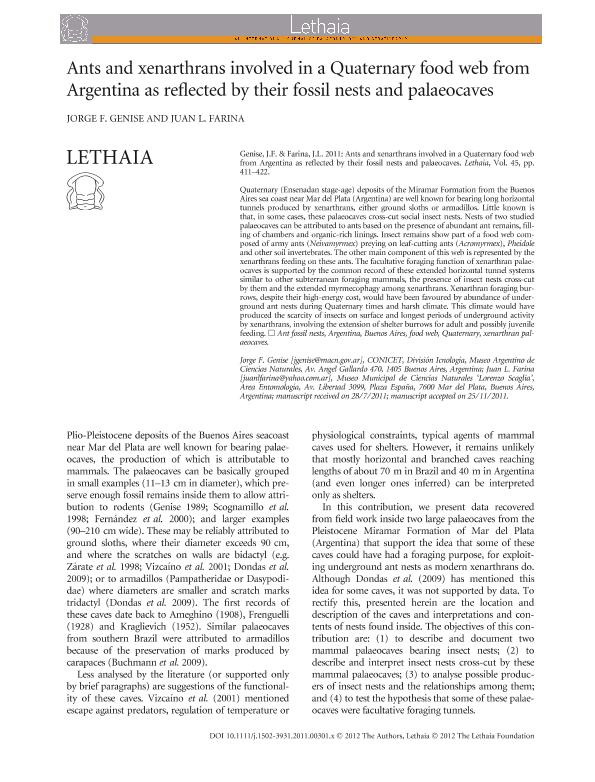Artículo
Ants and xenarthrans involved in a Quaternary food web from Argentina as reflected by their fossil nests and palaeocaves
Fecha de publicación:
07/2012
Editorial:
Wiley Blackwell Publishing, Inc
Revista:
Lethaia
ISSN:
0024-1164
Idioma:
Inglés
Tipo de recurso:
Artículo publicado
Clasificación temática:
Resumen
Quaternary (Ensenadan stage-age) deposits of the Miramar Formation from the Buenos Aires sea coast near Mar del Plata (Argentina) are well known for bearing long horizontal tunnels produced by xenarthrans, either ground sloths or armadillos. Little known is that, in some cases, these palaeocaves cross-cut social insect nests. Nests of two studied palaeocaves can be attributed to ants based on the presence of abundant ant remains, filling of chambers and organic-rich linings. Insect remains show part of a food web composed of army ants (Neivamyrmex) preying on leaf-cutting ants (Acromyrmex), Pheidole and other soil invertebrates. The other main component of this web is represented by the xenarthrans feeding on these ants. The facultative foraging function of xenarthran palaeocaves is supported by the common record of these extended horizontal tunnel systems similar to other subterranean foraging mammals, the presence of insect nests cross-cut by them and the extended myrmecophagy among xenarthrans. Xenarthran foraging burrows, despite their high-energy cost, would have been favoured by abundance of underground ant nests during Quaternary times and harsh climate. This climate would have produced the scarcity of insects on surface and longest periods of underground activity by xenarthrans, involving the extension of shelter burrows for adult and possibly juvenile feeding. □Ant fossil nests, Argentina, Buenos Aires, food web, Quaternary, xenarthran palaeocaves.
Palabras clave:
Paleocuevas
,
Hormigueros Fosiles
Archivos asociados
Licencia
Identificadores
Colecciones
Articulos(MACNBR)
Articulos de MUSEO ARG.DE CS.NAT "BERNARDINO RIVADAVIA"
Articulos de MUSEO ARG.DE CS.NAT "BERNARDINO RIVADAVIA"
Citación
Genise, Jorge Fernando; Farina, Juan Luis; Ants and xenarthrans involved in a Quaternary food web from Argentina as reflected by their fossil nests and palaeocaves; Wiley Blackwell Publishing, Inc; Lethaia; 45; 3; 7-2012; 411-422
Compartir
Altmétricas




